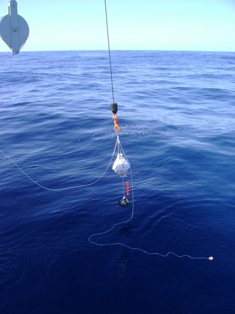Background
What needs to be measured?
To characterize the time-mean and time-varying components of the MOC in the South Atlantic, as well as the heat and fresh-water carried by the MOC, the international science community has agreed that it will be necessary to measure the full-water-column, full-basin-width, meridional velocity, temperature and salinity along a line of latitude in the South Atlantic.
Experience gained through the implementation of the North Atlantic MOC observing array at 26.5N suggests that it is critically necessary to obtain MOC estimates at a very high sampling rate, i.e. daily, to avoid aliasing high-frequency fluctuations into the semi-annual, annual, and longer periods that are of significant interest to climate studies. Tests of prospective array types in a variety of ocean models suggest that geostrophic-style mooring arrays, i.e., those which provide estimates of full-water-column density profiles, are likely to provide very accurate transport estimates for calculating the MOC. Care must be taken to design an array that is not so zonally sparse that it will provide insufficient heat and salt information for calculating meridional transports of those quantities. Moored arrays based on direct velocity measurements would not be cost effective for a trans-basin array, although focused use of direct measurements in the shelf regions and at depth along the continental slope will be crucial. In addition to a moored time-series array, it will also be important to collect western and eastern boundary hydrographic information, as well as trans-basin hydrographic sections for aid in the analysis and attribution of the moored observations.

Deployment of an inverted echo sounder
equipped with a bottom pressure recorder.
Picture courtesy of Chris Meinen, NOAA/AOML